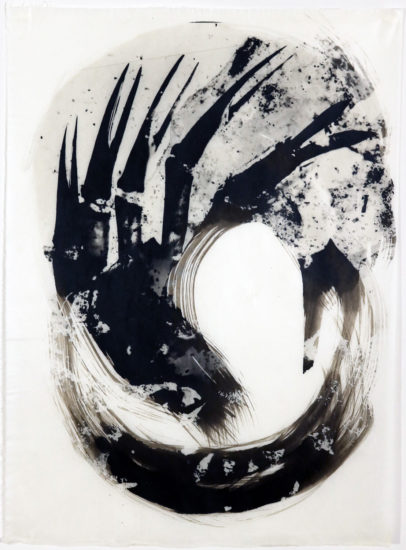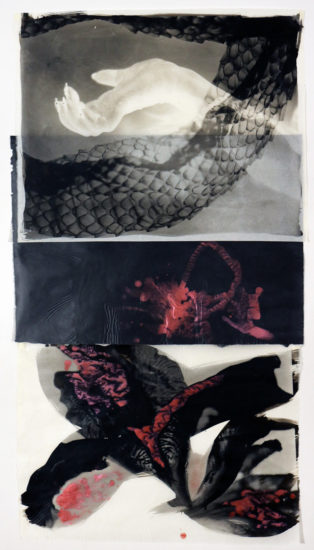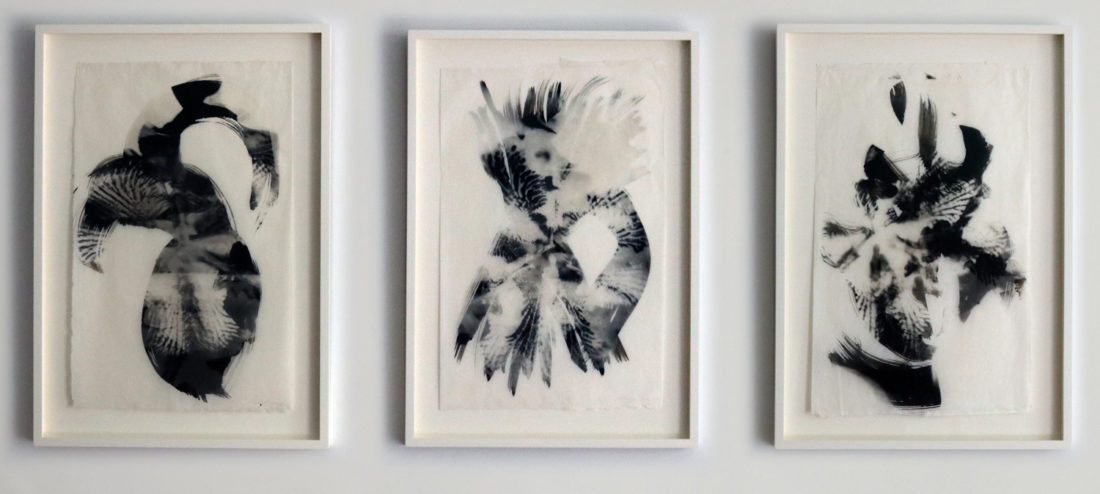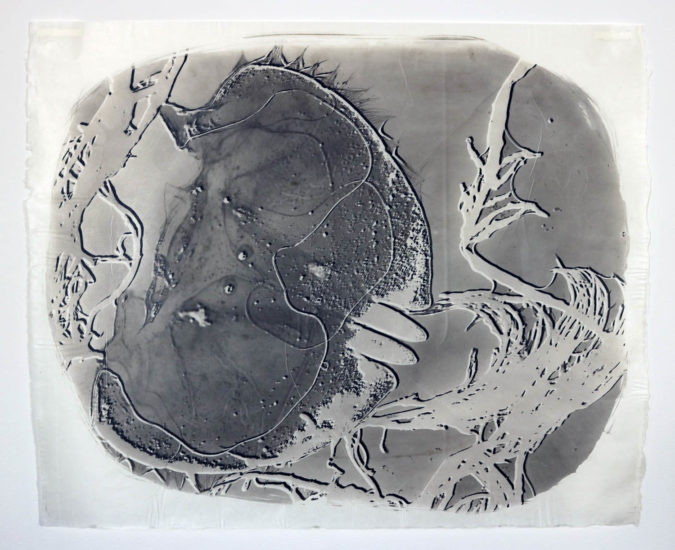Works Now Part of White Columns Curated Artist Registry
At the end of 2022, I received notice that my art works can be part of the celebrated White Columns curated artist registry. This work displayed here is one of the works in the registry. It is part of my work on the ocean where a wave carries and splashes on the extended claws of a horseshoe crab. I plan to add more works to the registry soon. The works on display there can be seen by typing in my name, Alice Garik, on the White Columns website: https://registry.whitecolumns.org
Collage about Woman.Life.Freedom Exhibited at Arts Gowanus
At Arts Gowanus Open Studios, one of the collages I exhibited is about the movement and protest by Iranian women for their rights in what is called: Woman.Life.Freedom. My works used flowers to symbolize the beauty of life and its fragility. Flowers are associated also with the cycle of life from seed to flowering to fruiting to death and then back to regeneration. The woman’s hand weaving through the snakeskin also alludes to the cycles of regeneration. The inspiration for this print is the ancient sculptures of the serpent divinity, usually a woman who holds and is embraced by snakes. The serpent is a symbol of feminine wisdom.
This particular art work is a response to the outcry by women in Iran and now all over the globe. Woman.Life.Freedom resonates with the transformation all women seek for equality, no matter where they live.
Go See My Palladium Prints On Exhibit at BWAC
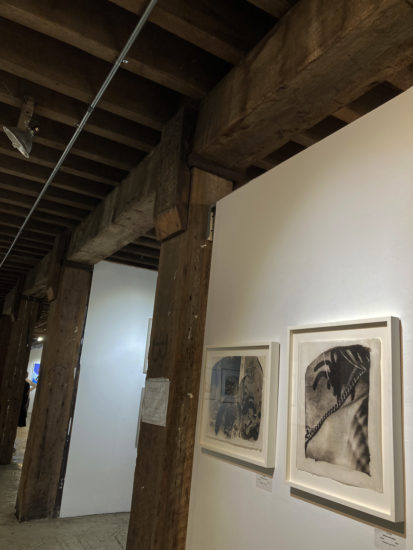
The Brooklyn Waterfront Artists Coalition, BWAC, is exhibiting “More Art of Coney Island”, a curated exhibition for the month of August, 2022. This is a juried show selected by Alicia Degener, co-president of BWAC.
Coney Island is considered to be the poor man’s Riviera. The artists in this exhibition have works depicting the multitudes of people who enjoy Coney Island. The artists represent people of all ages. One can almost hear the sounds of people laughing, talking, listening to music, shouting and even screaming when they go on the rides offered on Coney Island. The drawings, paintings, prints, textiles, and photographs show people on the boardwalk, on the beach, in the water, playing games and particularly participating in the annual Mermaid Parade. I think the Mermaid Parade honors the feminine archetype or Venus, who in mythology rose from the sea.
I am pleased to have my palladium prints of people with tattoos exhibited in this immense wooden building, once a warehouse, and now is a place for art and people to mingle.
Act Natural
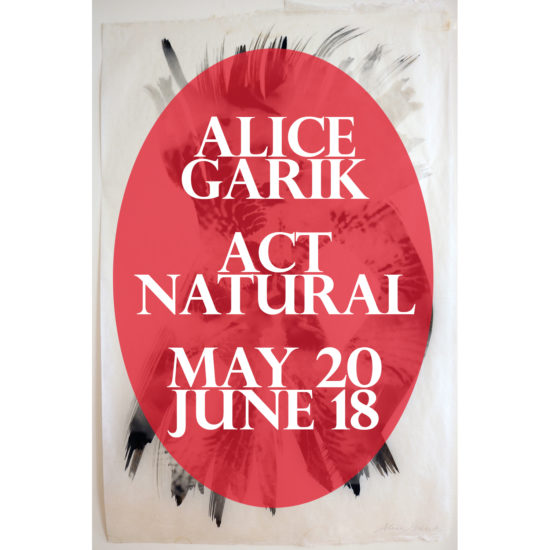
Act Natural is an online Berlin Collectiv group exhibition, May 20 through June 18, 2022 featuring art work related to the natural world.
“The secret of the human condition is that there is no equilibrium between humans and the surrounding forces of nature, which infinitely exceed us when we remain in inaction; there is only equilibrium in action by which humans recreate our own life through work.”
-Simone Weil, “Gravity and Grace”
Act Natural explores the themes of perception, connection and acceptance of the natural world in which we inherently exist and act upon. Many artists in this exhibition find grace through their work in what is traditionally perceived as a conflict between humans and nature. Philosopher Alan Watts clarifies our position: “You didn’t come in this world. You came out of it, like a wave from the ocean.”
The artists in this fine art exhibition are Nicole Cohen, Martha Colburn, Valerie Fuchs, Alice Garik, Gwen Kerber, Paul Paiement and Stephen Wozniak. Stephen Wozniak curated the exhibition.
While the work of participating artists in “Act Natural” may appear different upon cursory glance, there are numerous formal overlaps that indicate each artist’s desire to create deliberate, necessary and ostensibly rich aesthetic elements that point to the poetry of their preferred themes: visual perception, subjective experience, human creativity, and nature at large.
In 2022, now in the throes of political unrest, loss of life, systemic discrimination, a worldwide pandemic, economic upheaval, and eroding self worth, it is imperative to provide new work that helps fine art audiences to connect with the natural world, reset their lives, redefine their value, resolve our nominal differences and reclaim the place we call home on earth.
I believe that this online exhibition will help by presenting the works of “Act Natural” to a diverse audience that seeks personal healing, a reconnection to the natural world, community unification and movement forward.
Fragile Rainbow: Traversing Habitats
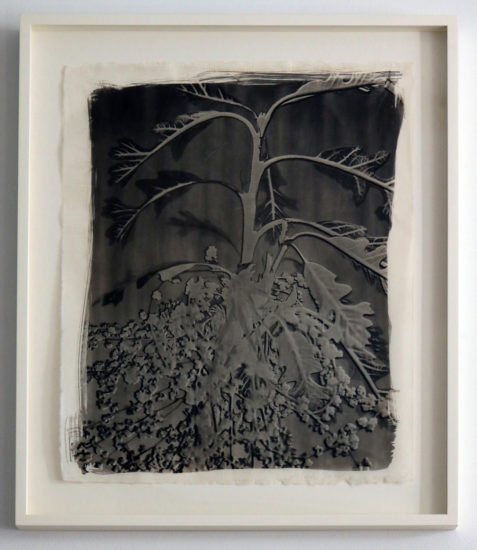
Opening on May 7th at the Williamsburg Art & Historical Center in Williamsburg, New York is an exhibit organized by ecoartspace of art focused on the environment by over 50 artists. The exhibit, named to reflect the fragility of nature: Fragile Rainbow: Traversing Habitats highlights nature in and surrounding the urban environment of New York City. The curator Sue Spaid created what will be a sensorial experience of works that amplify habitats’ various voices from birds to bladderwrack, clouds, cochineals, compost, coral reefs, cows, deer, flowers, fungi, human beings, jellyfish, knotweed, lichens, mangroves, metals, minerals, mugworts, mushrooms, plastic, rainbows, rivers, roots, rust, seeds, shells, soil, the sun, rivers, trees, watersheds, and worms.
One of my works, “Blossoming Oak Tree”, will be included in the exhibition.
The opening will be on Saturday, May 7, 3-5pm. The exhibition closes on Saturday, June 4, with a closing reception from 4-6pm. There will be events and talks taking place during the month of the exhibit.
Dreaming of Dragonflies

I work with animals, insects and plants and collage them with photographs I have done of our bodies to show our unity, in this time of climate crisis, with the natural world. I always enjoy watching dragonflies flying over ponds of water. I marvel at their wing span as they navigate near the water’s surface. I love how their wings reflect light as they flit and hover over water.
Dragonflies are known and sometimes revered all over the world. There are as many as 5000 species of dragonfly. Learning how many cultures have myths and beliefs associated with dragonflies has increased my own admiration and love for them.
One of the names of Japan is Akitsushima which means island of dragonflies. For Aboriginals in Australia dragonflies symbolize dancing and a reminder for humans to look within. In Welsh mythology, the word for dragonfly means snake’s servant, as they are often seen in the same environs as snakes. In the South West of the U.S., native Americans see dragonflies as the helper to bring rain and water in the dry areas. Celtic mythology has 23 names for the dragonfly.
In all these beliefs and myths, dragonflies are associated with change and transformation, particularly to bring more light and joy into our lives.
I have done this installation of dragonfly wings with close up of Iris flowers in palladium prints on Japanese gampi papers.
Technical Notes
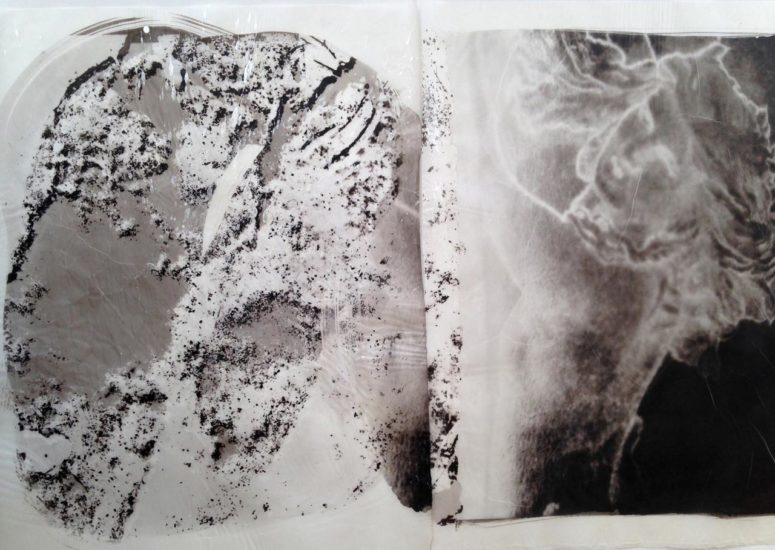
My work is a combination of experimental photographic techniques and hand-applied color. To make the photographic base image, I collage negatives of photographed tattoos with negatives of flora and fauna. For the tattoos, I photograph people’s tattoos with a 4X5″ camera and enlarge the negatives onto larger film in the darkroom. The negatives I use for my imagery of flora and fauna are camera-free. In the darkroom, I project a small object — a flower or a piece of seaweed, for example — onto negative film with my enlarger. I try to allow the shapes to take form in an organic process of discovery, working with various degrees of focus in the final image.
I then combine multiple negatives of tattoos with negatives of flora and fauna. Next, I paint palladium emulsion on handmade translucent Japanese gampi paper. Once the emulsion has dried, I place the negatives on it and top with glass and expose the image outdoors in the sun. It can take mere minutes in the summer or even hours in the winter for the image to form.
Depending on my ideas for each work, I may expose the work again with other negatives or paint it with water colors. Each unique work is process driven. At each stage I decide how the work is communicating.
Three Works in Curated Exhibit in GOS 2021
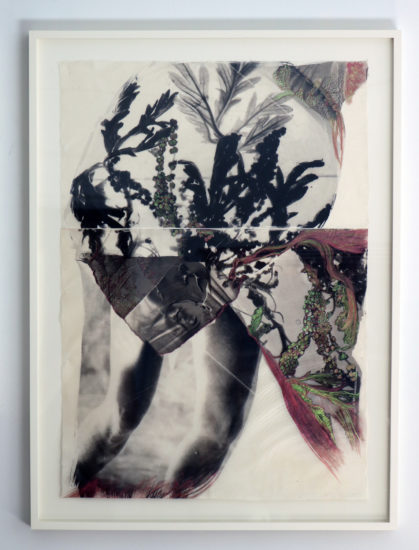
Yvena Despagne, a curator with Arts Gowanus, has chosen three of my works for “Oc.cu.pied”, an exhibition of art by women. The three works are “Blossoming Oak”, “Can We Breathe?” or “Chimera” and “Into the Earth”. I have used the title “Chimera” as an alternate title for this work as in Greek mythology chimeras were human hybrids with appendages from the natural world. Here this woman is growing blossoming Oak branches as she gives birth to her baby. Dates are October 16 and 17, the same timing as the Arts Gowanus Open Studios. Atelier Canal, 287 Third Ave., Brooklyn, NY 11215 is the location.
Framing my work finishes the work for me. The photograph here is the work “Can We Breathe” in its frame, ready to exhibit. I have given this work this name because we live in an interdependent state with trees. Through photosynthesis, trees transform carbon dioxide into oxygen which we breathe. This work is collaged from printing negatives of a woman, a baby and the blossoming oaks with palladium on Japanese gampi paper. I painted with Kremer pearlescent water color to add the dimension of green for leaves and red for our blood.
Iris Series for GOS 2021
On October 16th and 17th I am thrilled to display my new Iris series at Gowanus Open Studios, Brooklyn, NY from 12 – 6pm each afternoon. The address is Shapeshifter Lab, 18 Whitwell Place, Brooklyn, NY 11215.
My Iris Triptych series explores new ways to capture these flowers. Every year when the Iris blooms in Spring, I attempt to evoke their beauty and their spiritual essence. In Japan, Iris is revered for its purifying properties. In many cultures the Iris stands for wisdom, trust, hope and valor. What better flower to bloom as Spring begins?
This year I attempted to display this flower’s energy. Through the calligraphic movement I employed to paint the palladium on the Japanese gampi paper to the exposure using sunlight, my thought was to convey the elegance and dynamism of these flowers.
(Nature In) Lockdown Exhibition: Ocean Totems
Strands of seaweed, horseshoe crabs, shells, broken glass–ocean and human debris–the viscosity of salt water teeming with life–ebb and flow. When animals left the ocean for land, they took the sea with them. Our veins carry the same mixture of sodium, potassium and calcium as sea water. The ocean is our origin.
My hands forage for what the sea gives. I create prints to express its marvels.
A few of my palladium prints that I created from camera-less negatives of these sea fragments are part of an online exhibition https://fayddigital.com/Nature-in-lockdown published by this online magazine which works at the intersection of art, design and the environment.
